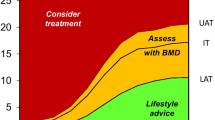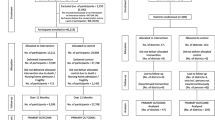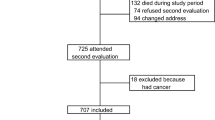Abstract
Summary
In assessing the risk of fractures, an important role is played by risk factors (RFs), the prevalence of which must be known among residents with different types of settlement in order to plan preventive measures in risk groups for fractures. Prevalence RFs varied depending on constituent entities and the settlement type.
Purpose
To investigate the prevalence of osteoporotic fractures (OPF) RFs and estimate absolute risk (AR) of OPF among urban vs rural residents of the Russian Federation.
Methods
In total, 13,391 Russian women and men 40–69 years old from 12 regions participated in the study. Groups of urban (n = 12,237) and rural (n = 1154) subjects were comparable in terms of their age. Participants were interviewed using a standard modular questionnaire. AR of OPF was calculated using the Russian FRAX model. Age-dependent diagnostic and therapeutic intervention thresholds (DIT, TIT) were employed to stratify AR of OPF.
Results
Among the OPF RFs, the most common were as follows: previous OPF (16.3%), causes of secondary osteoporosis (20.8%), and current smoking (17.9%). The frequencies of previous OPF and alcohol abuse in rural men were higher than in urban male residents. Urban women, compared with rural females, were characterized by such more frequent RFs as smoking and glucocorticoids’ intake. AR increased with age and prevailed in women, compared with men, regardless of their age, region of residence, and settlement type. According to TIT, the frequency of high AR of major OPF in the sample was 7.0%. According to DIT, high, medium, and low AR of major OPF was detected in 3.1%, 42.2%, and 54.7% of participants, respectively. Among urban women compared with rural females, high AR of major OPF was more often detected (p < 0.05), using TIT, whereas there was no such pattern for men. We discovered the territorial variability of RFs and OPF AR.
Conclusion
Prevalence of OPF RFs varied in Russia depending on age, gender, constituent entities, and the settlement type. Our data have demonstrated the typical age-gender causation pattern of OPF AR. Over 40% of participants required densitometry and fracture risk reclassification.



Similar content being viewed by others
References
Lesnyak O, Ershova O, Belova K, Gladkova E, Sinicina O, Ganert O, Romanova M, Khodirev V, Johannson H, McCloskey E, Kanis J (2012) Epidemiology of fracture in the Russian Federation and the development of a FRAX model. Arch Osteoporos 7(1–2):67–73. https://doi.org/10.1007/s11657-012-0082-3
Huntjens KMB, Kosar S, van Geel TA, Geusens PP, Willems P, Kessels A, Winkens B, Brink P, van Helden S (2010) Risk of subsequent fracture and mortality within 5 years after a non-vertebral fracture. Osteoporos Int 21(12):2075–2082. https://doi.org/10.1007/s00198-010-1178-5
Veronese N, Maggi S (2018) Epidemiology and social costs of hip fracture. Injury 49(8):1458–1460. https://doi.org/10.1016/j.injury.2018.04.015
Haentjens P, Magaziner J, Colón-Emeric CS, Vanderschueren D, Milisen K, Velkeniers B, Boonen S (2010) Meta-analysis: excess mortality after hip fracture among older women and men. Ann Intern Med 152(6):380–390. https://doi.org/10.7326/0003-4819-152-6-201003160-00008
Lesnyak OM, Baranova IA, Belova KYu, Gladkova EN, Evstigneeva LP, Ershova OB, Karonova TL, Yu Kochish A, Nikitinskaya OA, Skripnikova IA, Toroptsova NV, Aramisova RM (2018) Osteoporosis in Russian Federation: epidemiology, socio-medical and economical aspects (a review). Traumatol Orthop Russia 24(1):155–168 (In Russian)
Grinin VM, Shestemirova EI (2015) Current demographic ageing in Russia. Vestnik Rossiyskoy Akademii Meditsinskikh Nauk=Bull Russian Acad Med Sci 70(3):348–354. https://doi.org/10.15690/vramn.v70i3.1332
Melnichenko GA, Belaya ZE, Rozhinskaya LY, Toroptsova NV, Alekseeva LI, Biryukova EV, Grebennikova TA, Dzeranova LK, Dreval AV, Zagorodniy NV, Ilyin AV, Kryukova IV, Lesnyak OM, Mamedova EO, Nikitinskaya OA, Pigarova EA, Rodionova SS, Skripnikova IA, Tarbaeva NV, Farba LY, Tsoriev TT, Chernova TO, Yureneva SV, Yakushevskaya OV, Dedov II (2017) Russian federal clinical guidelines on the diagnostics, treatment, and prevention of osteoporosis. Issues Endocrinol 63(6):392–426. https://doi.org/10.14341/probl2017636392-426 (In Russian)
Schuit SCE, van der Klift M, Weel AEAM, de Laet CEDH, Burger H, Seeman E, Hofman A, Uitterlinden AG, van Leeuwen JPTM, Pols HAP (2004) Fracture incidence and association with bone mineral density in elderly men and women: the Rotterdam Study. Bone 34(1):195–202. https://doi.org/10.1016/j.bone.2003.10.001
Cranney A, Jamal SA, Tsang JRG, Leslie WD (2007) Low bone mineral density and fracture burden in postmenopausal women. CMAJ 177(6):575–580. https://doi.org/10.1503/cmaj.070234
Kanis JA, Johnell O, Oden A, Johannson H, McCloskey E (2008) FRAX and the assessment of fracture probability in men and women from the UK. Osteoporosis Int 19(4):385–397. https://doi.org/10.1007/s00198-007-0543-5
Centre for Metabolic Bone Diseases (2020) FRAX WHO fracture risk assessment tool. University of Sheffield, UK. https://www.sheffield.ac.uk/FRAX/tool.aspx?lang=rs. Accessed 4 July 2020
Kanis JA, Oden A, Johnell O, Johansson H, De Laet C, Brown J, Burckhardt P, Cooper C, Christiansen C, Cummings S, Eisman JA, Fujiwara S, Glüer C, Goltzman D, Hans D, Krieg MA, La Croix A, McCloskey E, Mellstrom D, Melton LJ 3rd, Pols H, Reeve J, Sanders K, Schott AM, Silman A, Torgerson D, van Staa T, Watts NB, Yoshimura N (2007) The use of clinical risk factors enhances the performance of BMD in the prediction of hip and osteoporotic fractures in men and women. Osteoporosis Int 18(8):1033–1046. https://doi.org/10.1007/s00198-007-0343-y
Brennan SL, Pasco JA, Urquhart DM, Oldenburg B, Hanna FS, Wluka AE (2010) The association between urban or rural locality and hip fracture in community-based adults: a systematic review. J Epidemiol Community Health 64(8):656–665. https://doi.org/10.1136/jech.2008.085738
Miller BJ, Cai X, Cram P (2012) Mortality rates are similar after hip fractures for rural and urban patients. Clin Orthop Relat Res 470(6):1763–1770. https://doi.org/10.1007/s11999-011-2140-3
Diamantopoulos AP, Hoff M, Skoie IM, Hochberg M, Haugeberg G (2013) Short- and long-term mortality in males and females with fragility hip fracture in Norway. A population-based study. Clin Interv Aging 8:817–823. https://doi.org/10.2147/CIA.S45468
Solbakken SM, Magnus JH, Meyer HE, Dahl C, Stigum H, Søgaard AJ, Holvik K, Tell GS, Emaus N, Forsmo S, Gjesdal CG, Schei B, Vestergaard P, Omsland TK (2019) Urban-rural differences in hip fracture mortality: a nationwide NOREPOS study. JBMR 3(11):e10236. https://doi.org/10.1002/jbm4.10236
Research Organizing Committee of the ESSE-RF project (2013) Epidemiology of cardiovascular diseases in different regions of Russia (ESSE-RF). The rationale for, and design of, the study. Prev Med 16(6):25–34 (In Russian)
Gladkova EN, Lesnyak OM, Ershova OB, Skripnikova IA, Anoshenkova ON, Ahverdyan YuR, Belova KYu, Belousova IB, Bol’shakova EV, Grebenkina MV, Dreval’ AV, Zavodovskij BV, Zotkina KE, Il’in MV, Kasimova AM, Kolchinskij IA, Kosmatova OV, Kryukova IV, Ahatov AF, Latfullin AA, Lejkauskene EA, Leonova NV, Maksimova YuV, Myagkova MA, Novikov VE, Polyakova EYu, Polyakova YuV, Sivordova LE, Tavluev VA (2021) Comparison of the effectiveness of different approaches to osteoporosis diagnosis organizingand identification of patients at high fracture risk in the Russian population. Russian J Prev Med 24(10):8–14. https://doi.org/10.17116/profmed20212410114 (In Russian)
Osteoporosis. Clinical guidelines 2021. In: Russian. https://cr.minzdrav.gov.ru/recomend/87_4. Accessed 4 Feb 2022
Nikitinskaya OA, Toroptsova NV (2017) The prevalence of clinical risk factors for osteoporosis and osteoporotic fractures of distal forearm in residents of five cities in the Volga Federal District. Modern Medicine, Neurology/Rheumatology 5(1):42–46 (In Russian)
Ershova OB, Sinitsyna OS, Belova KYu, Degtyarev AA, Ganert OA, Romanova MA, Nazarova AV (2013) Result of the analysis of risk factors and absolute risk of fractures (FRAX) in men with fractures of the proximal femur. Osteoporos Osteopath 16(1):3–6. https://doi.org/10.14341/osteo201313-6 (In Russian)
Balanova YuA, Kontsevaia AV, Shalnova SA, Deev AD, Artamonova GV, Gatagonova TM, Dupliakov DV, Efanov AYu, Zhernakova YuV, Il’in VA, Konradi AO, Libis RA, Minakov AV, Nedogoda SV, Oganov RG, Oshchepkova EV, Romanchuk SV, Rotar OP, Trubacheva IA, Shliakhto EV, Boitsov SA (2014) Prevalence of behavioral risk factors for cardiovascular diseases in the Russian population: results of the ESSE-RF epidemiological study. Prev Med 17(5):42–52 (In Russian)
Nikitinskaya OA, Toroptsova NV (2017) Evaluating 10-year probability of osteoporotic fractures via Russian FRAX model in population-based samples of five regions in Russia. Meditsinskiy Sovet Med Counc 1S:103–107. https://doi.org/10.21518/2079-701X-2017-0-103-107 (In Russian)
Strom O, Borgstrom F, Kanis JA, Compston J, Cooper C, McCloskey EV, Jönsson B (2011) Osteoporosis: burden, health care provision and opportunities in the EU. A report prepared in collaboration with IOF and EFPIA. Arch Osteoporos 6(1–2):59–155. https://doi.org/10.1007/s11657-011-0060-1
Leslie WD, Morin S, Lix LM, Johansson H, Oden A, McCloskey E, Kanis JA (2012) Fracture risk assessment without bone density measurement in routine clinical practice. Osteoporos Int 23(1):75–85. https://doi.org/10.1007/s00198-011-1747-2
Nikitinskaya OA, Toroptsova NV, Nasonov EL (2018) Risk factors for osteoporosis in men 40 years of age or older: the results of the Osteoscreening-Russia program. Modern Rheumatol J 12(3):76–81. https://doi.org/10.14412/1996-7012-2018-3-76-81 (In Russian)
Pigarova EA, Rozhinskaya LYa, Katamadze NN, Povaliaeva AA, Troshina EA (2020) Prevalence of vitamin D deficiency in various regions of the Russian Federation: results of the first stage of the multicenter cross-sectional randomized study. Osteoporos Osteopath 23(4):4–12. https://doi.org/10.14341/osteo12701 (In Russian)
Myagkova M, Skripnikova I, Shalnova S, Deev A (2019) Absolute risk of osteoporotic fractures (FRAX®) and welfare indicators in urban population of the Russian Federation. Osteoporos Int 30(Suppl 2):S398–S399
Acknowledgements
The authors express their sincere gratitude to the regional study coordinators: E.V. Indukaeva1, G.V. Tolparov2, Y.I. Grinstein3, A.Y. Efanov4, V.A. Ilyin5, N.V. Kulakova6, S.V. Nedogoda7, S.V. Romanchuk8, A.N. Redko9, I.A. Viktorova10, N.N. Prishchepa11, S.S. Yakushin12, representing the following institutions:
1Institute for Complex Problems of Cardiovascular Diseases, Siberian Branch of the Russian Academy of Medical Sciences, Kemerovo, Russia
2North Ossetian State University, Vladikavkaz, Russia
3Krasnoyarks State Medical University, Krasnoyarsk, Russia
4Tyumen State Medical University, Tyumen, Russia
5Institute for Social and Economic Development of the Territories, Russian Academy of Sciences, Vologda, Russia
6Pacific State Medical University, Vladivostok, Russia
7Volgograd State Medical University, Volgograd, Russia
8Regional Cardiological Center, Ivanovo, Russia
9Kuban State Medical University, Krasnodar, Russia
10Omsk State Medical University, Omsk, Russia
11Center for Medical Prevention of the Republic of Karelia, Petrozavodsk, Russia
12Pavlov State Medical University of Ryazan, Ryazan, Russia
Author information
Authors and Affiliations
Corresponding author
Ethics declarations
Ethical approval
All procedures performed in studies involving human participants were conducted in accordance with the ethical standards of the institutional and national research committees, and with 1964 Declaration of Helsinki and its later amendments or compatible ethical standards.
Informed consent
Informed consent was obtained from all individual participants included in the study.
Conflicts of interest
None.
Additional information
Publisher’s note
Springer Nature remains neutral with regard to jurisdictional claims in published maps and institutional affiliations.
Rights and permissions
About this article
Cite this article
Skripnikova, I.A., Myagkova, M.A., Shalnova, S.A. et al. Epidemiology of risk factors and estimating 10-year probability of osteoporotic fractures in the Russian Federation. Arch Osteoporos 17, 62 (2022). https://doi.org/10.1007/s11657-022-01093-x
Received:
Accepted:
Published:
DOI: https://doi.org/10.1007/s11657-022-01093-x




